Contents of this article
- 1. Blood type matching table
- 2. Comparison table of parent’s blood type and child’s blood type, blood type encyclopedia
- 3. What blood type can be matched with what blood type?
- 4. Is the blood type comparison table between father and son correct?
blood type matching table
About blood type matching table
Regarding the blood group matching table, blood type is a classification based on the differences in homologous antigens on the surface of red blood cells. Due to the different agglutinogens contained in red blood cells, blood is divided into several types, so it is called blood type. Let’s take a look at the relevant content about the blood type matching table.
Blood type matching table 1
1. Type A and Type A - Type A, Type O;
2. Type A and Type B - Type A, Type B, Type O, Type AB;
3. Type A and AB - type A, type B, type AB;
4. Type A and Type O - Type A and Type O;
5. Type B and Type A - Type A, Type B, Type O, Type AB;
6. Type B and Type B - Type B, Type O;
7. Type B and AB - type A, type B, type AB;
8. Type B and Type O - Type B and Type O;
9. Type O and Type A - Type O, Type A;
10. Type O and Type B - Type O, Type B;
11. Type O and Type AB - Type A, Type B;
12. Type O and Type O - Type O;
13. Type AB and type A - type A, type B, type AB;
14. Type AB and type B - type A, type B, type AB;
15. Type AB and type AB - type A, type B, type AB;
16. AB type and O type - type A, type B;
17. Type AB and other types - type A, type B but not type O.
Blood type matching table 2
Blood transfusion matching table
Blood is considered the source of life for the human body, and everyone donates blood in their daily lives. So when giving hope and life force to others, you should also pay attention. There is also a big difference between blood types. So what is the blood type matching for transfusion?
The agglutination reaction of blood transfusion is a fatal symptom that can seriously endanger a person's life. Therefore, transfusion of blood containing antibodies against the recipient's blood group antigens should be avoided. Therefore, type B blood cannot be transfused to type A blood, and type A blood cannot be transfused to type B blood.
Type AB blood does not contain anti-A and anti-B antibodies, so it can theoretically accept heterotypic blood transfusions; type O blood is the opposite of AB, containing both anti-A and anti-B antibodies, so it cannot accept heterotypic transfusions, but it does not contain A. and B antigens, which can be transfused to people with blood types A, B, or AB when needed. This is why type O blood is often called "universal transfusion recipients".
But with the advancement of science, this statement is no longer true. It is now discovered that transfusing type O blood containing immune antibodies to type A or type B patients can increase the fragility of their red blood cells, shorten their lifespan, and in severe cases, hemolytic reactions can occur. Therefore, type O blood is not a universal blood donor.
People with AB blood type are not universal blood recipients. Although the red blood cells of people with O blood type do not contain A and B antigens, their serum contains antibodies
Blood type matching table 3
Couple blood type matching chart
1. Husband A + Wife A. The best-matched couple seems to have a dull relationship, but is very close when they are just two people.
2. Husband A + Wife O, a rigid couple who stick to routines and stick to habits.
3. Husband A + Wife B, a couple with reversed status. The husband is controlled by his wife’s actions.
4. Husband A + Wife AB, a couple playing a game, with the wife completely dependent on the husband.
5. Husband B + Wife B, a couple who go their own way and don’t worry about the future.
6. Husband B + Wife O, a couple where the woman makes the decision, and the wife uses her strength to suppress the husband.
7. Husband B + Wife A, a talkative husband who uses quarrels as a pastime.
8. Husband B + wife AB, a capable couple seeking development on their own paths.
9. Husband O + Wife O, couples who compete with each other often restrict each other.
10. Husband O + Wife A, a couple where the man calls the shots, the husband concentrates on work and the wife takes care of the housework.
11. Husband O + Wife B, a disturbing couple, quarrels are proof of harmony.
12. Husband O + wife AB, a heartless couple who can spend as much money as they want.
13. Husband AB + Wife AB, a couple that is difficult to understand. They feel suffocated when they are too close.
14. Husband AB + Wife A, a couple who are dependent on their wives. The husband regards his wife as a substitute for his mother.
15. Husband AB + wife O, husband and wife who are very different, need to keep a distance from each other.
16. Husband AB + Wife B, a love slave couple, the wife cannot live without her husband.
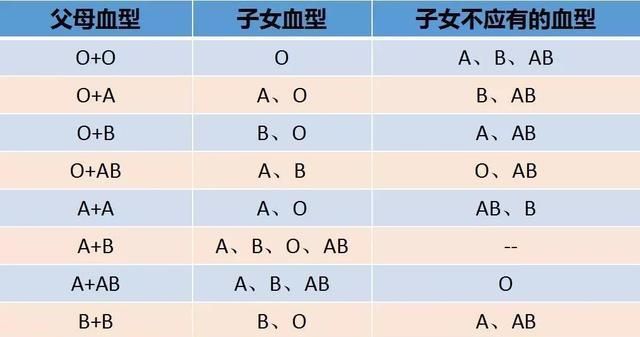
Parent blood type and child blood type comparison table blood type encyclopedia
Parents’ blood type and child’s blood type comparison table
Comparison table of parent's blood type and child's blood type. Everyone's blood type is inherited from their parents. The ancient blood type paternity test was measured by blood type. Let’s take a look at the comparison table of parents’ blood types and children’s blood types and related content.
Parents’ blood type and child’s blood type comparison table 1
The blood type genetic pattern table is also called the blood type matching table. As long as you know the blood types of you and your partner, you can determine the possible blood type of the baby born in the future. This is the most scientific method of blood type testing and blood type matching known.
Blood type is a classification based on the differences in homologous antigens on the surface of human red blood cells. Due to the different agglutinogens contained in human red blood cells, blood is divided into several types, so it is called blood type. There are many types of human blood types, and each blood type system is determined by genetic factors and has immunological properties.
The most common blood group system is the ABO blood group, which is divided into four types: A, B, AB, and O; the second is the Rh blood group system, which is mainly divided into Rh positive and Rh negative; and the third is the MN and MNS blood group systems. According to current clinical tests at home and abroad, there are more than 30 human blood types.
We humans have many blood types, and each blood type is determined by genetic factors. The most common blood type is ABO blood type, followed by Rh blood type, and MN and MNSs blood types. Blood type inheritance is when the blood type genes of both parents are combined in the cells of both sexes, and the genetic characteristics of the blood type are passed on to the offspring. Different blood types have different genetic genes:
The genetic gene of type A blood can be the combination of A and A of both sexes to form AA, or it can be the combination of A gene of one sex and O of the other sex to form AO. However, regardless of whether AA or AO, the blood type shown is A. type, and O is a recessive genetic gene that cannot be expressed.
The genes of type B blood are similar to those of type A blood. Some are BB and some are BO, but they all show B.
The genetic genes of AB and O blood types are consistent with the displayed blood types. AB type is AB and O type is OO. It can be seen that if the father or mother has type A or B blood, their children may be type A. Or type B, but it may also be type O, because type A or type B both contain the recessive genetic gene O. When the O in the paternal genetic gene combines with the O in the maternal genetic gene to form OO, it will appear as type O. .
Parents’ blood type and child’s blood type comparison table 2
How is blood type inherited?
Human blood types are hereditary. When the blood type genes of both parents are combined in hermaphrodite cells, they can be paired in the nuclear chromosomes, thereby passing on the blood type genetic characteristics to their offspring. Different blood types have different genetic genes.
When the blood type is passed on to offspring, the parents' reproductive cells (sperm and egg) each provide one of a pair of genes to reassemble a pair of genes. For example, if the father's blood type is type A, the pair of genes that control the blood type is AO. When sperm is formed, the pair of AO genes separate from each other and enter two sperm respectively, that is, they become sperm with the A gene and sperm with the O gene. .
If the mother's blood type is B, the pair of genes that control the blood type is BO. Similarly, during egg formation, an egg with B gene and an egg with O gene are formed. During fertilization, if the father's sperm with A gene and When an egg carrying the B gene is combined, an AB-type individual (fetus) will be formed, and the blood type will be AB. If a sperm carrying the O gene fertilizes an egg carrying the B gene, an individual (fetus) with the OB gene will be formed, and its blood type is B. If a sperm carrying the O gene and an egg carrying the O gene combine to form an individual with the OO gene, the blood type is O.
blood type genetic chart
Blood type inheritance is determined by genes located on chromosomes. Our human cells contain 23 pairs of chromosomes, half of which come from the father and the other half from the mother. These chromosomes carry thousands of genetic genes from each parent, which are passed down from generation to generation.
The inheritance of the three ABO antigens is controlled by three alleles respectively. The blood type gene is a multiple allele. Three blood type genes can appear at the relative position, namely A, B or O, so the sum of the genes at the relative position There are six combinations of AA, BB, OO, AB, AO or BO, which are called genetic formulas. A or B is a dominant gene, and O is a recessive gene. The phenotypes corresponding to the above genetic formulas are A, B, O, AB, A, and B. In fact, they are A, B, O, and AB. type.
When sperm and egg cells combine, the opposite chromosomes of the father and mother are paired up, so that half of a certain trait of the parents is passed on to the children. For example, if the father's blood type is A, his genetic formula is AO or AA. Assume For AO, half of the germ cells carry type A genes and the other half carry type O genes. If the mother is type B, her genetic formulas are BO and BB. If she is BO, her children will have types A, B, O, and AB. Assuming that the mother has type BB, the phenotype of her children will be type AB or type B.
Parent blood type and child blood type comparison table 3
Blood type and personality
Why can blood type determine a person's personality and temperament? After years of research, it is believed that blood type has two effects: tangible substance and intangible temperament. Temperament is an intangible component. The temperament expression of a blood type is the specific way of thinking, behavior, and conversational style of people with this blood type. It is the result of biological inheritance.
There are three attitudes of O-type people: they like to compare power with others, they are sensitive to good and evil, and they value trust and friendship.
The personality characteristics of Type A people are the spirit of sacrifice and dedication, and coordination. Actively serve others and pay attention to the atmosphere around you. Loves loneliness, easily conceals one's sincerity, and cannot trust others.
The personality characteristics of Type B people are that they are very neurotic about their physical condition and can express their feelings relatively freely; they are indifferent to the people and things around them; they are active and unrestrained in their actions, have dexterous thinking, and have a wide range of interests.
Type AB people are natural pacifists, and they really know how to enthusiastically do things that are not beneficial to themselves, or run for public affairs. His actions are sharp, hot and cold, and he is often regarded as a heretic. They often follow their own path and do not take the initiative to join the group.
Around everyone, everyone has to come into contact with many people and things in their life. People with different blood types do have different personalities. When we interact with others, we can also reasonably use the knowledge that blood type determines personality to communicate with others, or get twice the result with half the effort.
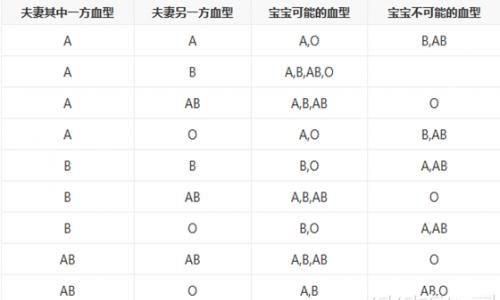
What blood type can be matched with what blood type?
Everyone has their own blood type . The four common blood types are type A, type B, type O, and type AB. What kind of blood type will be produced if two of them match? So below, blood type analysis will reveal to you the blood type matching table? Let’s take a look next!
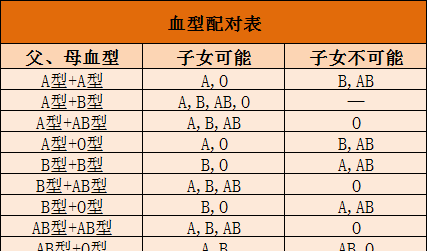
blood type matching table
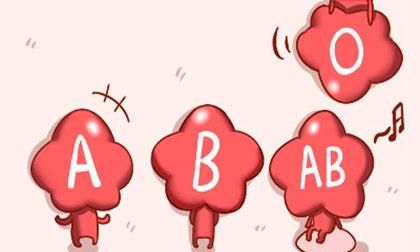
Blood type matching table What blood type matches which blood type
1. Type A and type A - type A, type O;
2. Type A and type B - type A, type B, type O, type AB;
3. Type A and type AB - type A, type B , AB type;
4. Type A and type O - type A, type O;
5. Type B and type A - type A, B Type, O type, AB type;
6, B type and B type - B type, O type;
7, B type and AB type - Type A, type B, type AB;
8, type B and type O - type B, type O;
9, type O and type A - - Type O, Type A;
10, Type O and Type B - Type O, Type B;
11, Type O and Type AB - A Type, type B;
12, type O and type O - type O;
13, type AB and type A - type A, type B, Type AB;
14, type AB and type B - type A, type B, type AB;
15. Type AB and type AB - type A, type B, type AB;
16. Type AB and type O - type A, type B;
17. Type AB and other types - type A, type B but not type O.
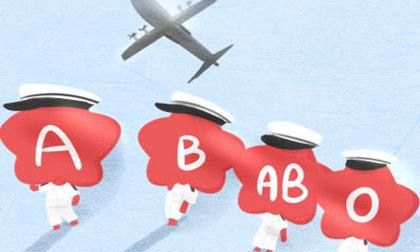
Extended information:
Blood type genetic rule table is also called blood type matching table. As long as you enter your and your partner's blood types, you can determine the possible blood types of your baby born in the future. This is the most scientific method of blood type testing and blood type matching known.
Blood type is a classification based on the differences in homogeneous antigens on the surface of human red blood cells. Due to the different agglutinogens contained in human red blood cells, blood is divided into several types, so it is called blood type.
There are many types of human blood types, and each blood type system is determined by genetic factors and has immunological properties. The most common blood group system is the ABO blood group, which is divided into four types: A, B, AB, and O; the second is the Rh blood group system, which is mainly divided into Rh positive and Rh negative; and the third is the MN and MNS blood group systems. According to current clinical tests at home and abroad, there are more than 30 human blood types.
Blood groups (blood types) are a genetic trait expressed in the form of blood antigens.
Is the blood type comparison chart between father and son correct?
If both parents' blood types are type O, their children's blood type can only be type O blood. In addition, there are many different possibilities for the combination of parents' blood types. For example, if the father is A and the mother is B, then the child is A, B, AB, or O. Blood type is a classification based on the differences in homologous antigens on the surface of human red blood cells.
The blood type comparison table is as follows:
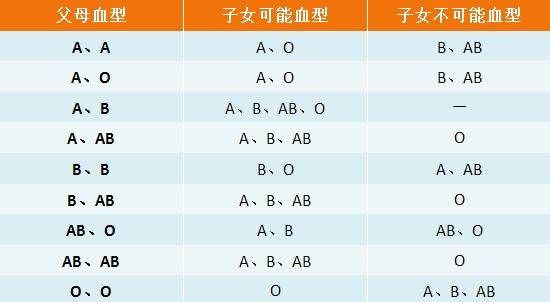
Extended information
Blood type
ABO blood type:
ABO blood groups divide blood into four blood groups based on the presence of antigen A and antigen B on the red blood cell membrane. Only antigen A on red blood cells is type A, and only antigen B is type B. If both A and B antigens are present, it is type AB. Those with neither antigen are type O. The serum of people with different blood types contains different antibodies, but they do not contain antibodies against their own red blood cell antigens. For example: Type A blood serum only contains anti-B antibodies. Among people of all ethnic groups in my country, type A, type B and type O blood each account for about 30%, while type AB only accounts for about 10%.
The above is all about the parent-child blood type matching chart, the blood type matching chart, and the related content of the blood type matching test. I hope it can help you.
